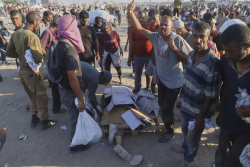Vladimir Medinsky’s statements reveal Moscow’s fear that Ukraine might follow Azerbaijan’s path, militarily reclaiming occupied territory, undermining the Kremlin’s imperial ambitions across the former Soviet Union.
Vladimir Medinsky is no stranger to controversy. Medinsky combines a modern version of Rasputin, the grey cardinal behind the Tsarist throne, with a Soviet ideological commissar. As a former minister of culture and the president’s speechwriter, Medinsky has helped shape the ideological contours of Russian imperial nationalism, which has intensified since 2012, when Vladimir Putin returned to the presidency.
Putin’s infamous essay, published eight months before the full-scale invasion of Ukraine, which Medinsky ghostwrote, denies the existence of Ukraine and a Ukrainian people. The essay made the spurious claim of alleged “genocide” of Russian speakers by the “Nazi Kyiv regime.”
Why Is Russia Comparing Azerbaijan and Ukraine?
Earlier this month, Medinsky again stepped into controversy by making another false comparison between the Armenian-Azerbaijani and Russian-Ukrainian wars. Describing Karabakh and southeast Ukraine as disputed regions, he raised the fear that if Russia and Ukraine sign a ceasefire agreement, as did Armenia and Azerbaijan in the early 1990s, then there will be a similar outcome of eventual loss of control.
In 2020 and 2023, Azerbaijan used military force to retake twenty percent of its territory that had been under Armenian occupation, including the Karabakh region. Medinsky fears that in the future, Ukraine would launch a similar military operation to liberate four Ukrainian regions annexed by Russia in September 2022.
Kremlin leaders routinely blame NATO and the West for supporting former Soviet republics, such as Azerbaijan and Ukraine, and providing them with military assistance. In addition, the Kremlin has never viewed the non-Russian successor republics as possessing full sovereignty and agency because it has always viewed Eurasia as Russia’s exclusive sphere of influence.
Additionally, Azerbaijan and Ukraine are distinct from each other.
Russia’s Comparison of Azerbaijan and Ukraine Is Wrong
The infamous Section 907 of the 1992 US Freedom Support Act denied security and other forms of assistance to Azerbaijan. Azerbaijan has been a strategic ally of and has militarily cooperated with Israel and Turkey for an extended period before its 2020 military operation to liberate its occupied lands. In 2020 and 2023, Azerbaijani military forces independently liberated occupied territories.
As with Section 907 towards Azerbaijan, the US (and Europe) also denied Ukraine security and military assistance. After Russia’s first invasion in 2014, US President Barack Obama ignored US security commitments to Ukraine under the 1994 Budapest Memorandum and vetoed congressional support for military assistance.
The US and Europe only began to supply military assistance to Ukraine from April 2022, after the Kyiv region was liberated from Russian invading forces. Since then, military aid has been sufficient to prevent Ukraine from being defeated, but it has never been enough to conquer Russia. Meanwhile, Ukraine has launched hundreds of domestic defense companies, which now produce 60 percent of its military needs.
NATO has never had any intention to become militarily involved in the South Caucasus or Ukraine. Medinsky brings up the NATO canard because Russian imperial nationalists continue to be unable to accept that Azerbaijanis and Ukrainians have independent agency and are not Russia’s “younger brothers.’”
Medinsky’s interview earlier this month follows in the tradition of all Kremlin leaders in giving support to Armenia. From the late 1980s, the conflict was fanned by Soviet and Russian leaders who provided military support to Armenian separatists and the Armenian nationalist dream of a “Greater Armenia.”
Why Does Russia Support Armenia Instead of Azerbaijan?
Russian imperial nationalists have historically aligned with Armenia due to two key factors. The first is the comparison between Christianity and Islam, specifically. The second is geopolitics: Armenia is a member of Russia-led organisations in Eurasia, such as the Collective Security Treaty Organisation (CSTO) and Eurasian Economic Union, while Azerbaijan is not.
Armenia’s gratitude for Soviet and Russian support in the late 1980s and early 1990s was evident in allowing itself to become the first Russian puppet state. Belarusian President Alexander Lukashenka was forced to become a Russian puppet state only in 2020 after the Kremlin assisted him in defeating mass protests.
Armenia had already become a Russian puppet state two decades earlier when it agreed to open two Russian military bases, allow the Russian Federal Security Service (FSB) to patrol its borders, and the Kremlin to take over its energy sector.
The Kremlin always supported separatism in former Soviet republics. During Boris Yeltsin’s presidency in the 1990s, the Kremlin manufactured conflicts and backed separatists in the Karabakh region of Azerbaijan, the Transnistria region of Moldova, and the provinces of South Ossetia, Abkhazia, and Ajaria in Georgia. Yeltsin’s Machiavellian divide and rule policies failed in Crimea, but Putin invaded and annexed the peninsula in 2014.
The Kremlin’s proxy wars against four former Soviet republics aimed to maintain them within Russia’s Eurasian sphere of influence. Medinsky is angry because only Azerbaijan, by liberating its occupied territories, has removed Russia’s influence from the South Caucasus, thus ending the Kremlin’s long-running divide et impera (divide and rule) policies.
Russia Is Losing Its Influence in Its “Near Abroad”
Medinsky, like other Kremlin leaders, is afraid that Ukraine will follow Azerbaijan and, in the future, also liberate its regions that are currently occupied, however, he fails to understand the similarities between Azerbaijan and Ukraine. The similarity lies in that Armenia established a proxy state in Artsakh (the Armenian nationalist name for Karabakh).
At the same time, Russia set up two proxy entities in the Donbas region of eastern Ukraine, the so-called Donetsk People’s Republic (DPR) and Luhansk People’s Republic (LPR).
Another similarity that Medinsky ignores is that Azerbaijan and Ukraine have never violated the territorial integrity of a country or waged war against any state. Russia and Armenia were the only two former Soviet successor states that have never accepted the 21 December 1991, Almaty Declaration, which declared that Soviet republican boundaries would become international frontiers.
Of the fifteen former Soviet republics, only Russian and Armenian imperial nationalists have pursued irredentist claims against their neighbours. The dream of Greater Armenia came to an end in 2020 and 2023. Medinsky and the Kremlin are fearful that the dream of a Russian Empire will come crashing down when Ukraine liberates its occupied territories.
Azerbaijan, Ukraine, and other Soviet successor states are fully sovereign and independent states that do not need a paternalistic ’elder brother’ and will decide their own domestic and foreign policies.
Medinsky, like Putin, lives in the nineteenth century.
However, as Azerbaijan demonstrated when it defeated a Greater Armenia, there is no room in the twenty-first century for empires. Medinsky revealed the fears of the Kremlin that its occupation of Ukrainian land will unravel when Ukraine follows Azerbaijan’s example.
About the Author: Taras Kuzio
Taras Kuzio is a professor of political science at the National University of Kyiv Mohyla Academy. He is co-editor of Russia and Modern Fascism: New Perspectives on the Kremlin’s War Against Ukraine; co-author of The Four Roots of Russia’s War Against Ukraine; Crimea: Where Russia’s War Started and Where Ukraine Will Win, and Russian Nationalism and the Russian-Ukrainian War .
Image Credit: Shutterstock/Viacheslav Lopatin.


















